 Loading...
Loading...

Anti-FGFR1 Recombinant Antibody Products
 Loading...
Loading...Anti-FGFR1 Products
- Anti-Human FGFR1 Recombinant Antibody (FR1-H7) (TAB-052WM)
-
- Derivation: Phage-displayed human Fab library
- Species Reactivity: Human
- Type: Human Antibody
- Application: ELISA, Neut
-
- Derivation: Humanized
- Species Reactivity: Human
- Type: Human IgG
- Application: WB, IHC
-
- Derivation: Humanized
- Species Reactivity: Human
- Type: ADCC enhanced antibody
-
- Species Reactivity: Human, Mouse
- Type: Human IgG
- Application: ELISA
- Mouse Anti-FGFR1 Recombinant Antibody (HPAB-3044LY) (HPAB-3044LY)
-
- Species Reactivity: Human
- Type: Mouse IgG
- Application: ELISA
-
- Derivation: Mouse
- Species Reactivity: Human
- Type: Mouse IgG1, κ
- Application: WB, ICC, IHC
-
- Species Reactivity: Human
- Type: Rabbit IgG
- Application: WB, ICC, IF
-
- Type: Mouse IgG2b
- Application: ELISA, WB
- Mouse Anti-FGFR1 Recombinant Antibody (VS3-FY2705) (VS3-FY2705)
-
- Species Reactivity: Human, Mouse
- Type: Mouse IgG
- Application: WB, IHC, ICC
- Rabbit Anti-FGFR1 Recombinant Antibody (clone CBACN-225) (MRO-0578-CN)
-
- Species Reactivity: Human
- Type: Rabbit IgG
- Application: WB, IF
-
- Species Reactivity: Human
- Type: Human IgG
- Application: ELISA
-
- Species Reactivity: Human
- Type: Human IgG
- Application: ELISA
-
- Species Reactivity: Human
- Type: Human IgG
- Application: ELISA
-
- Species Reactivity: Human
- Type: Human IgG
- Application: ELISA
-
- Species Reactivity: Human
- Type: Human IgG
- Application: ELISA
- Human Anti-FGFR1 Recombinant Antibody (HPAB-0701-FY) (HPAB-0701-FY)
-
- Species Reactivity: Human
- Type: Mouse IgG1
- Application: ELISA
- Human Anti-FGFR1 Recombinant Antibody (HPAB-N0346-YC) (HPAB-N0346-YC)
-
- Species Reactivity: Human, Rat, Mouse, Monkey
- Type: Human IgG1
- Application: ELISA, FuncS
-
- Species Reactivity: Human
- Type: Human IgG
- Application: ELISA
-
- Species Reactivity: Human
- Type: Mouse antibody
- Application: WB, IP, IHC
- Mouse Anti-FGFR1 Recombinant Antibody (clone CBL537) (NEUT-825CQ)
-
- Species Reactivity: Human
- Type: Mouse IgG1
- Application: WB, Neut
-
- Species Reactivity: Human
- Type: Mouse IgG1
- Application: WB, Neut
- Mouse Anti-FGFR1 Recombinant Antibody (clone CBL059) (NEUT-827CQ)
-
- Species Reactivity: Human
- Type: Mouse IgG1
- Application: Neut, WB
- Human Anti-FGFR1 Recombinant Antibody (HPAB-0118-FY) (HPAB-0118-FY)
-
- Species Reactivity: Human, Monkey
- Type: Human IgG1
- Application: ELISA
- Anti-Human FGFR1 Recombinant Antibody scFv Fragment (FR1-H7) (TAB-052WM-S(P))
-
- Derivation: Phage-displayed human Fab library
- Species Reactivity: Human
- Type: Human Antibody
- Application: ELISA, BL, Neut
-
- Species Reactivity: Human, Mouse
- Type: Human scFv
- Application: ELISA
- Anti-Human FGFR1 Recombinant Antibody Fab Fragment (FR1-H7) (TAB-052WM-F(E))
-
- Derivation: Phage-displayed human Fab library
- Species Reactivity: Human
- Type: Human Antibody
- Application: ELISA, BL, Neut
-
- Derivation: Mouse
- Species Reactivity: Human
- Type: Mouse IgG2b
- Application: WB, ELISA, FC, ICC, IF, IHC
- Human Anti-FGFR1 Recombinant Antibody; Fab Fragment (TAB-054WM-F(E)) (TAB-054WM-F(E))
-
- Species Reactivity: Human, Mouse
- Type: Human Fab
- Application: ELISA
- Mouse Anti-FGFR1 Recombinant Antibody; Fab Fragment (TAB-053WM-F(E)) (TAB-053WM-F(E))
-
- Species Reactivity: Human
- Type: Mouse Fab
- Application: WB
-
- Species Reactivity: Human
- Type: Mouse scFv
- Application: WB
- Human Anti-FGFR1 Recombinant Antibody scFv Fragment (HPAB-N0346-YC-S(P)) (HPAB-N0346-YC-S(P))
-
- Species Reactivity: Human, Rat, Mouse, Monkey
- Type: Human scFv
- Application: ELISA, FuncS
- Human Anti-FGFR1 Recombinant Antibody Fab Fragment (HPAB-N0346-YC-F(E)) (HPAB-N0346-YC-F(E))
-
- Species Reactivity: Human, Rat, Mouse, Monkey
- Type: Human Fab
- Application: ELISA, FuncS
- Human Anti-FGFR1 Recombinant Antibody Fab Fragment (HPAB-0701-FY-F(E)) (HPAB-0701-FY-F(E))
-
- Species Reactivity: Human
- Type: Human Fab
- Application: ELISA
- Human Anti-FGFR1 Recombinant Antibody scFv Fragment (HPAB-0701-FY-S(P)) (HPAB-0701-FY-S(P))
-
- Species Reactivity: Human
- Type: Human scFv
- Application: ELISA
-
- Species Reactivity: Human
- Type: Human scFv
- Application: ELISA
- Human Anti-FGFR1 Recombinant Antibody; scFv Fragment (HPAB-0118-FY-S(P)) (HPAB-0118-FY-S(P))
-
- Species Reactivity: Human, Monkey
- Type: Human scFv
- Application: ELISA
- Human Anti-FGFR1 Recombinant Antibody; Fab Fragment (HPAB-0118-FY-F(E)) (HPAB-0118-FY-F(E))
-
- Species Reactivity: Human, Monkey
- Type: Human Fab
- Application: ELISA
- Human Anti-FGFR1 Recombinant Antibody (clone 121-R3P1-A9/H10); scFv Fragment (HPAB-0486LY-S(P))
-
- Species Reactivity: Human
- Type: Human scFv
- Application: ELISA
- Human Anti-FGFR1 Recombinant Antibody (clone 121-R3P1-B1/E12); scFv Fragment (HPAB-0487LY-S(P))
-
- Species Reactivity: Human
- Type: Human scFv
- Application: ELISA
- Human Anti-FGFR1 Recombinant Antibody (clone 121-R3P1-C1); scFv Fragment (HPAB-0488LY-S(P))
-
- Species Reactivity: Human
- Type: Human scFv
- Application: ELISA
- Human Anti-FGFR1 Recombinant Antibody (clone 121-R3P1-C7); scFv Fragment (HPAB-0489LY-S(P))
-
- Species Reactivity: Human
- Type: Human scFv
- Application: ELISA
- Human Anti-FGFR1 Recombinant Antibody (clone 121-R3P1-E1); scFv Fragment (HPAB-0490LY-S(P))
-
- Species Reactivity: Human
- Type: Human scFv
- Application: ELISA
-
- Species Reactivity: Human
- Type: Human Fab
- Application: ELISA
- Mouse Anti-FGFR1 Recombinant Antibody; scFv Fragment (HPAB-3044LY-S(P)) (HPAB-3044LY-S(P))
-
- Species Reactivity: Human
- Type: Mouse scFv
- Application: ELISA
- Mouse Anti-FGFR1 Recombinant Antibody; Fab Fragment (HPAB-3044LY-F(E)) (HPAB-3044LY-F(E))
-
- Species Reactivity: Human
- Type: Mouse Fab
- Application: ELISA
- Human Anti-FGFR1 Recombinant Antibody (clone 121-R3P1-A9/H10); Fab Fragment (HPAB-0486LY-F(E))
-
- Species Reactivity: Human
- Type: Human Fab
- Application: ELISA
- Human Anti-FGFR1 Recombinant Antibody (clone 121-R3P1-B1/E12); Fab Fragment (HPAB-0487LY-F(E))
-
- Species Reactivity: Human
- Type: Human Fab
- Application: ELISA
- Human Anti-FGFR1 Recombinant Antibody (clone 121-R3P1-C1); Fab Fragment (HPAB-0488LY-F(E))
-
- Species Reactivity: Human
- Type: Human Fab
- Application: ELISA
- Human Anti-FGFR1 Recombinant Antibody (clone 121-R3P1-C7); Fab Fragment (HPAB-0489LY-F(E))
-
- Species Reactivity: Human
- Type: Human Fab
- Application: ELISA
- Human Anti-FGFR1 Recombinant Antibody (clone 121-R3P1-E1); Fab Fragment (HPAB-0490LY-F(E))
-
- Species Reactivity: Human
- Type: Human Fab
- Application: ELISA
-
- Species Reactivity: Human
- Type: Mouse IgG
- Application: WB, FC
- Rabbit Anti-FGFR1 Recombinant Antibody (VS13-YC392) (VS13-YC392)
-
- Species Reactivity: Human
- Type: Rabbit IgG
- Application: WB, ICC, IF
-
- Species Reactivity: Human
- Target: FGFR1
- Host Animal: Human
- Application: ELISA, FC, Neut, Cell-uptake
- Anti-FGFR1 Immunohistochemistry Kit (VS-0525-XY2538)
-
- Species Reactivity: Human
- Target: FGFR1
- Application: IHC
- Anti-Mouse FGFR1 Immunohistochemistry Kit (VS-0525-XY2539)
-
- Species Reactivity: Human, Mouse, Rat
- Target: FGFR1
- Application: IHC
-
- Species Reactivity: Human, Monkey
- Type: Human IgG1
- Application: ELISA
-
- Species Reactivity: Human, Monkey
- Host Animal: Human
- Target: FGFR1
- Application: ISZ, Cyt, FuncS
- Human Anti-FGFR1 (clone FR1-H7) scFv-Fc Chimera (VS-0125-FY35)
-
- Species Reactivity: Human
- Type: Human IgG1, scFv-Fc
- Application: ELISA, Neut
-
- Derivation: Mouse
- Species Reactivity: Human
- Type: Mouse IgG
- Application: WB, ELISA
-
- Derivation: Phage display library
- Species Reactivity: Human
- Type: Rabbit IgG
- Application: WB
Can't find the products you're looking for? Try to filter in the left sidebar.Filter By Tag
Our customer service representatives are available 24 hours a day, from Monday to Sunday. Contact Us
For Research Use Only. Not For Clinical Use.
Creative Biolabs offers a wide array of high-quality anti-FGFR1 recombinant antibodies, precisely engineered for diverse immunological research. These antibodies are designed for exceptional precision and specificity, allowing researchers to study FGFR1 in various biological processes accurately.
FGFR1: A Potential Target for Cancer Therapy
FGFR1 (fibroblast growth factor receptor type 1), a receptor tyrosine kinase essential for normal development and physiology, has been implicated in oncogenesis when aberrantly activated. Amplification of FGFR1 is particularly prevalent in pulmonary squamous cell carcinomas, and preclinical studies have shown its potential as a therapeutic target. Given its high involvement in cancer development, targeting FGFR1 is expected to be an effective approach to cancer treatment.
Alternative Names
Fibroblast growth factor receptor 1; FGFR1_HUMAN; heparin-binding growth factor receptor 1; BFGFR; C-FGR; CD331; CEK; FLG; FMS-like gene; FLT2; hydroxyaryl-protein kinase; FMS-like tyrosine kinase 2; N-SAM tyrosine kinase; protein-tyrosine kinase; tyrosyl protein kinase; KAL2.
Background
Cancer-related genes, CD markers, Disease related genes, Enzymes, FDA approved drug targets, Human disease related genes, Metabolic proteins, Plasma proteins, RAS pathway related proteins, Transporters
Intracellular, Membrane (different isoforms)
Cell type enhanced (Leydig cells, Fibroblasts, Oligodendrocyte precursor cells)
Low immune cell specificity
Cell line enhanced (AN3-CA, BJ hTERT+)
Monomer. Homodimer after ligand binding. Interacts predominantly with FGF1 and FGF2, but can also interact with FGF3, FGF4, FGF5, FGF6, FGF8, FGF10, FGF19, FGF21, FGF22 and FGF23 (in vitro) (PubMed:1697263, PubMed:1722683, PubMed:8663044, PubMed:9655399, PubMed:12181353, PubMed:16597617, PubMed:17623664). Ligand specificity is determined by tissue-specific expression of isoforms, and differences in the third Ig-like domain are crucial for ligand specificity. Affinity for fibroblast growth factors (FGFs) is increased by heparan sulfate glycosaminoglycans that function as coreceptors. Likewise, KLB increases the affinity for FGF19, FGF21 and FGF23 (PubMed:19966287). Interacts (phosphorylated on Tyr-766) with PLCG1 (via SH2 domains) (PubMed:1656221, PubMed:1379697, PubMed:21765395). Interacts with FRS2 (PubMed:21765395). Interacts with RPS6KA1 (PubMed:15117958). Interacts (via C-terminus) with NEDD4 (via WW3 domain) (PubMed:21765395). Interacts with KL (By similarity). Interacts with SHB (via SH2 domain) (PubMed:12181353). Interacts with GRB10 (PubMed:10454568). Interacts with ANOS1; this interaction does not interfere with FGF2-binding to FGFR1, but prevents binding of heparin-bound FGF2 (PubMed:19696444). Interacts with SOX2 and SOX3. Interacts with FLRT1, FLRT2 and FLRT3 (By similarity). Found in a ternary complex with FGF1 and ITGAV:ITGB3 (PubMed:20422052, PubMed:18441324).
Heparin-binding, Kinase, Receptor, Transferase, Tyrosine-protein kinase
Anti-FGFR1 Recombinant Antibody Products
Creative Biolabs provides a wide range of recombinant antibodies that target FGFR1 and are specifically designed for reliable identification and neutralization. With a number of formats available, these antibodies exhibit outstanding specificity and affinity, making them useful for a wide range of applications. Whether for study or therapeutic development, Creative Biolabs' anti-FGFR1 antibodies are critical instruments for expanding knowledge in immunology, cancer, and other related areas.
Table 1. Featured anti-FGFR1 recombinant antibody products at Creative Biolabs.
| Cat. No. | Product Name | Target Species | Host Species | Applications |
| TAB-283CL | Human Anti-FGFR1 Recombinant Antibody | Human | Human IgG | WB, IHC |
| TAB-052WM | Anti-Human FGFR1 Recombinant Antibody (FR1-H7) | Human | Human Antibody | ELISA, Neut |
| HPAB-0701-FY | Mouse Anti-FGFR1 Recombinant Antibody (clone Ab21) | Human, Mouse | Mouse IgG1 | ELISA |
| HPAB-0118-FY | Human Anti-FGFR1 Recombinant Antibody | Human, Monkey | Human IgG1 | ELISA |
| HPAB-3044LY | Mouse Anti-FGFR1 Recombinant Antibody | Human | Mouse IgG | ELISA |
Creative Quality Control
Creative Biolabs specializes in delivering high-quality anti-FGFR1 recombinant antibodies designed specifically for research applications. With cutting-edge amenities along with robust quality control strategies, we ensure that our products have exceptional specificity and binding affinity. Our team of experienced biotechnology professionals is dedicated to enhancing our methods and providing reliable solutions to support your scientific research and projects.
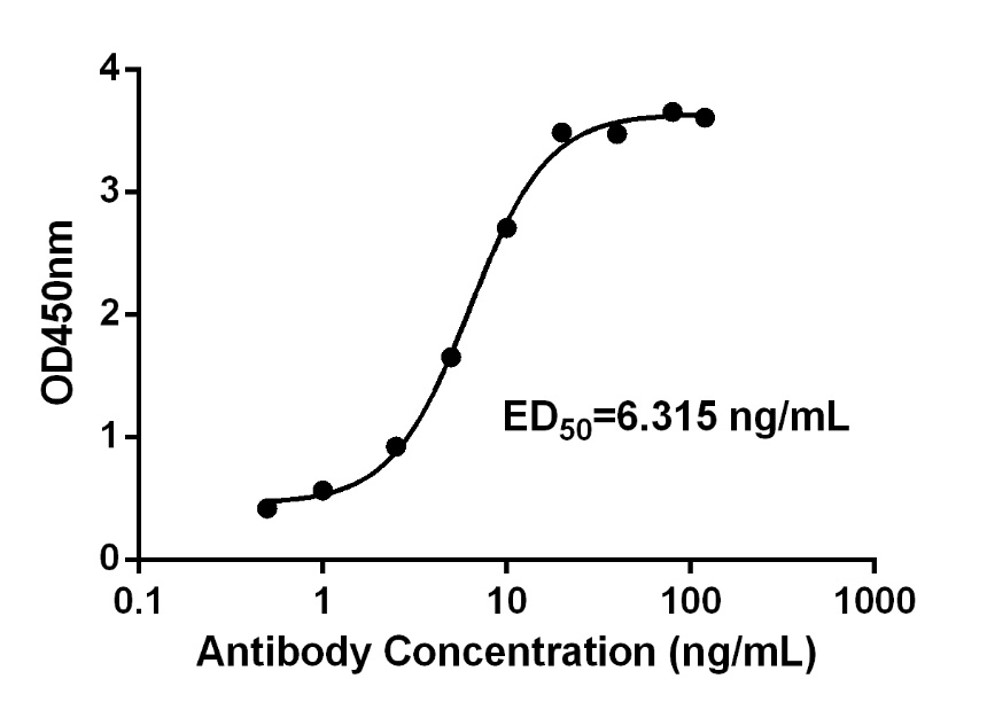 Fig.1 ELISA analysis of anti-FGFR1 antibody
Fig.1 ELISA analysis of anti-FGFR1 antibody
(Cat# TAB-052WM, Creative Biolabs).
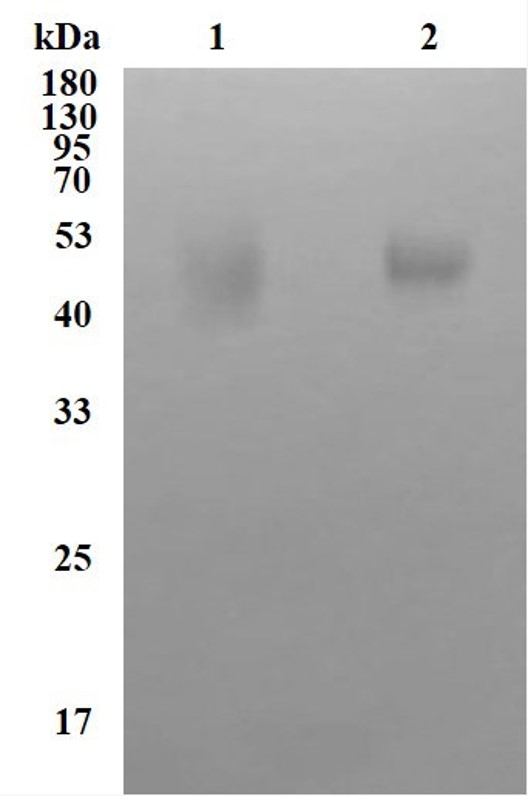 Fig.2 WB analysis of anti-FGFR1 antibody
Fig.2 WB analysis of anti-FGFR1 antibody
(Cat# TAB-052WM, Creative Biolabs).
Customer Reviews

Mouse Anti-FGFR1 Recombinant Antibody (clone 20H8) (MOB-1638z)

Human Anti-FGFR1 Recombinant Antibody (clone SEEDbody A08) (HPAB-N0346-YC)

Human Anti-FGFR1 Recombinant Antibody (HPAB-0118-FY) (HPAB-0118-FY)
Anti-FGFR1 Recombinant Antibody Production
Creative Biolabs employs a novel recombinant antibody production technology particularly tailored for the synthesis of anti-FGFR1 antibodies. Our cutting-edge genetic engineering technologies enable the flexible synthesis of high-quality antibodies, ensuring a constant and reliable supply to support your various research purposes.
Featured Anti-FGFR1 Recombinant Antibody Production Platforms 
Fig.3 Milligram-scale anti-FGFR1 recombinant antibody production.
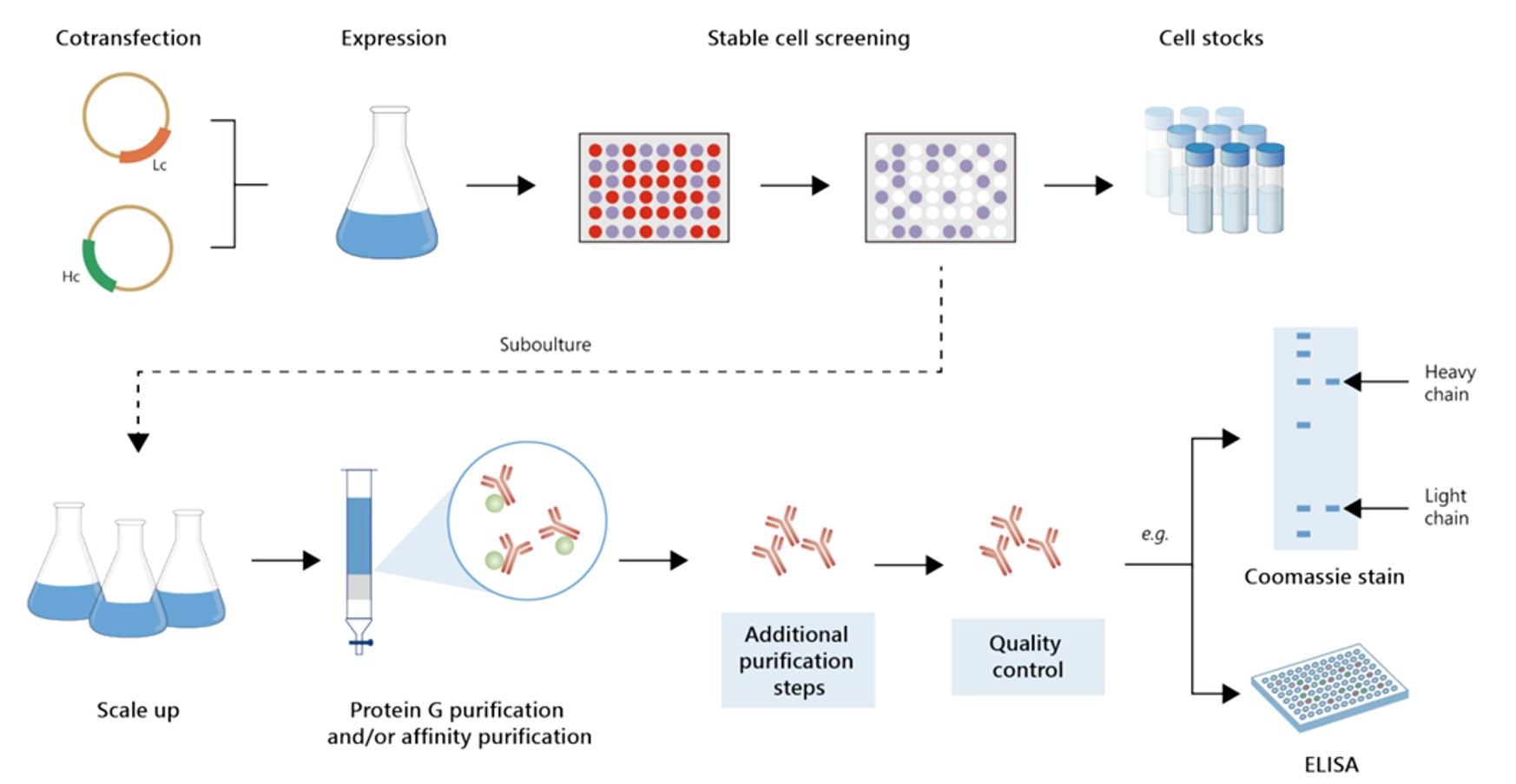 Fig.4 Gram-scale anti-FGFR1 recombinant antibody production.
Fig.4 Gram-scale anti-FGFR1 recombinant antibody production.
Anti-FGFR1 Recombinant Antibody Modalities
Creative Biolabs provides a comprehensive selection of high-quality anti-FGFR1 recombinant antibodies in a variety of forms to address the unique demands of scientists worldwide.
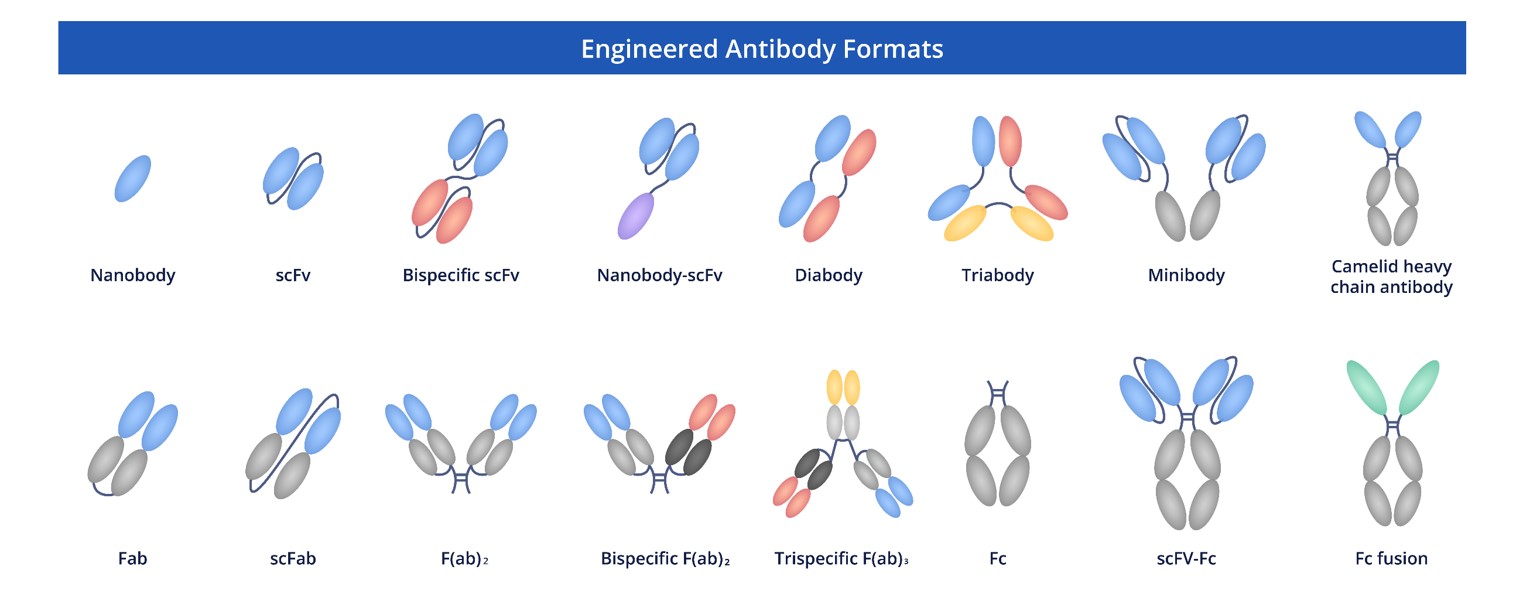 Fig.5 Full-length anti-FGFR1 recombinant antibody production and modalities.
Fig.5 Full-length anti-FGFR1 recombinant antibody production and modalities.
FGFR1-Targeted Drug Information
Public Drug Information Targeting FGFR1
Table 2. Public drug targeting FGFR1.
| Company | Research Phase | Classification | Condition |
| RemeGen (Originator) | Phase III |
Fc Fusion Proteins Polypeptides, from 41 AA |
Diabetic macular edema Retinopathy, diabetic Wet macular degeneration (exudative) |
|
Merck & Co Merck & Co. (Merck & Co) NGM Biopharmaceuticals (Originator) |
Phase II |
Agonist Antibodies Humanized Monoclonal Antibodies |
Diabetes type 2 Non-alcoholic steatohepatitis (NASH) Obesity |
|
Amgen (Originator) Five Prime Therapeutics (Amgen) GlaxoSmithKline (GSK) GSK Human Genome Sciences (GSK) |
Phase II |
Cancer Immunotherapy Fc Fusion Proteins Polypeptides, from 41 AA |
Cancer Cancer, breast Cancer, endometrium Cancer, lung (non-small cell) (NSCLC) (squamous cell carcinoma) Cancer, ovary Cancer, solid tumor Mesothelioma, malignant |
|
Merck & Co (Originator) Thomas Jefferson University (Originator) |
Phase II |
Acidic Fibroblast Growth Factor (aFGF; FGF-1) Polypeptides, from 41 AA Recombinant proteins |
Lesion, skin Restenosis, arterial |
| Phage Pharmaceuticals (Originator) | Phase I |
Acidic Fibroblast Growth Factor (aFGF; FGF-1) Polypeptides, from 41 AA Recombinant proteins |
Ear Disorders Ulcer foot, diabetic |
|
Chugai Pharmaceutical Genentech (Originator) |
Discontinued |
Bispecific Antibodies Monoclonal Antibodies |
Diabetes type 2 Insulin resistance Non-alcoholic steatohepatitis (NASH) |
| Novo Nordisk (Originator) | Preclinical |
Fibroblast Growth Factors (FGF) Polypeptides, from 41 AA Recombinant proteins |
Non-alcoholic fatty liver disease (NAFLD) |
| Fifth Peoples' Hospital of Shanghai (Originator) | Preclinical |
MicroRNA Single-stranded oligoribonucleotide (RNA) |
Cancer, lung (non-small cell) (NSCLC) |
|
EMD Serono (Originator) Ligand (Originator) Merck KGaA (Originator) |
Preclinical |
Cancer Immunotherapy Human Monoclonal Antibodies |
Cancer, lung |
| AstraZeneca (Originator) | Preclinical |
Bispecific Antibodies Human Monoclonal Antibodies |
Valvular heart disorders |
(Disclaimer: The information in this table is just for knowledge sharing and not for marketing or sales purposes.)
Creative Biolabs is a leading provider of high-quality anti-FGFR1 recombinant antibodies. Our products are designed for precision and specificity, making them appropriate for a variety of research applications. Contact our scientific team to discuss your specific needs and explore how our anti-FGFR1 antibodies can contribute to your research goals.


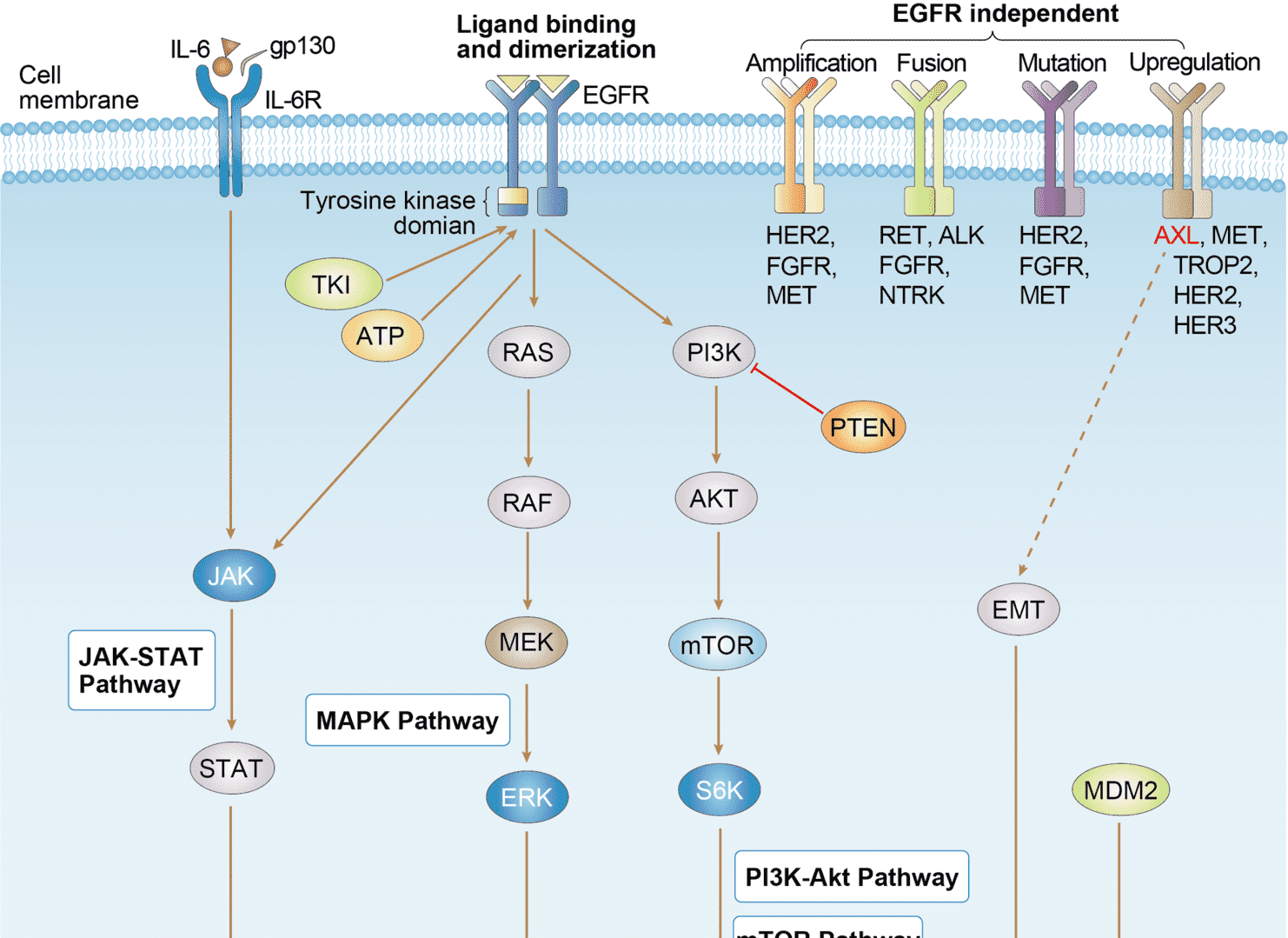 EGFR Tyrosine Kinase Inhibitor Resistance
EGFR Tyrosine Kinase Inhibitor Resistance

